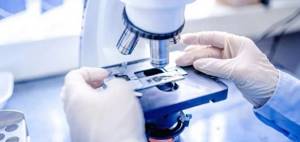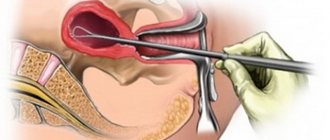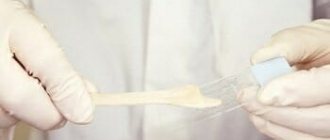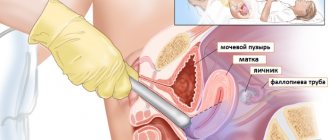Cytological examination of smears from the cervix allows one to assess the condition of the mucous membrane, the presence or absence of signs of pathological processes (reactive, precancerous, tumors). When other laboratory methods identify an infectious agent (human papillomavirus, bacterial and parasitic infections), the cytological method allows one to evaluate the body’s response to the infectious agent, the presence or absence of signs of damage, proliferation, metaplasia or transformation of the epithelium. It is also possible, by examining a smear, to determine the cause of changes in the epithelium (the presence of inflammation with an approximate or confident determination of pathogenic microbiota (microflora), pathological processes associated with hormonal, medicinal, mechanical, radiation effects on the woman’s body and the cervix, conditions fraught with the risk of dysplasia and cervical cancer, and when they develop, establish the correct diagnosis.In this regard, cytological examination is used both for screening (smears from a visually normal cervix) and in the presence of changes in the mucous membrane visible during a gynecological examination.
Benefits of cervical cytology
This analysis has the following advantages:
- minimal invasiveness;
- acceptable cost of such research;
- high precision;
- lack of complex training;
- efficiency of obtaining final results;
- safety and painlessness;
- the possibility of carrying it out multiple times;
- diagnosing diseases even at an early stage.
A possible problem with such a study can only be the fact that material will need to be collected from the affected areas, which creates difficulties if the specific location of the tumor or inflammation is not clear, but the symptoms of this pathology are present.
Rod flora
Such a record is a sign of women's health. The patient's genital tract contains lactobacilli (Doderlein bacilli), which synthesize lactic acid and maintain an acidic environment that prevents the development of pathogenic bacteria. Having received this result, you don’t have to worry - everything is fine in your body.
However, if E. coli is found instead of Doderlein bacilli, that’s a completely different story. This microorganism must be in the intestines, and its entry into neighboring organs leads to inflammatory processes - colpitis, cystitis and urethritis. The reasons for the detection of the pathogen are wearing dirty underwear, poor hygiene by the woman or her partner. Antibiotics are prescribed for treatment.
Indications
For annual prevention, doctors recommend performing such an analysis as cervical cytology for girls from the 21st age. After 65, with 3 previously negative results, such screening is not considered mandatory.
In general, indications for cytology are:
- frequent childbirth;
- menopause period;
- pregnancy planning;
- the absence of this research over the past 2-3 years;
- early birth (before 18);
- the presence of obvious structural changes in the genital tract identified during a gynecological examination (cervical erosion, for example);
- preparation for installation of an intrauterine device;
- presence of cancer in close relatives;
- infertility;
- HPV (or human papillomavirus);
- disrupted menstrual cycle;
- taking hormonal medications;
- genital herpes;
- a lot of extra weight.
How to Prepare for a Pap Test
It is recommended to take the test no earlier than on the 5th day of the menstrual cycle and no later than 5 days before the start of menstruation. On the eve and on the day of the study, do not douche the vagina, and 2-3 days before, avoid the use of fat-containing vaginal preparations (suppositories, creams, vaginal tablets). During menstruation, as well as earlier than 24-48 hours after sexual intercourse, intravaginal ultrasound and colposcopy, a smear is not taken!
To eliminate the risk of developing this serious disease, take care of your health, make an appointment with a gynecologist at CITILAB and perform a Pap test based on the liquid cytology method - 90-69-502 - Cytological examination of scrapings of the cervix, cervical canal, vagina with staining Papanicolaou (material taken in liquid transport medium).
Be healthy!
Author:
Baktyshev Alexey Ilyich, General Practitioner (family doctor), Ultrasound Doctor, Chief Physician
Preparation and process of cytology analysis
Before a cervical cytology test is taken, it is prescribed by the attending physician for specific indications. However, if cervical cytology is required, preparation for the test is also necessary. It provides for the exclusion of baths and douching 3 days before collecting biomaterial, abstaining from urination 2 hours, exclusion of intimate life also 3 days before the test and a ban on the use of suppositories, creams, tampons or tablets inserted into the vagina. This is necessary to obtain a correct and objective result.
The smear itself for atypical cells is considered mandatory during a comprehensive gynecological examination. It is carried out with the patient positioned on a special gynecological chair, during which a doctor of appropriate competence, conducting an examination using a miniature mirror, uses an Eyre spatula. This is a special instrument designed for scraping from the vaginal mucosa - it is taken first. But then, if necessary, an endobrush (or a probe with a small diameter) is used to collect cellular material from the endocervix. Then the collected material is applied to a glass slide, fixed, and then transferred directly to the laboratory. The laboratory assistant stains the smear and microscopes it (examines it under a microscope). Attention is drawn to the structure of the material, namely its internal contents, shape, outer shell, cell size and their location along with their quantity. All recorded changes are then displayed in the final report. At the end of the procedure, the patient should feel well and be able to perform all her usual activities. If, over the course of a couple of days, the patient notices bloody discharge or painful sensations that are uncharacteristic during this period, it means that blood vessels were affected during cytology. In this case, it is important to consult a doctor again.
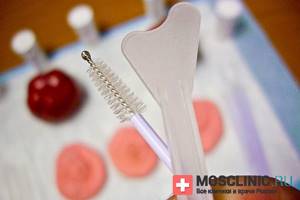
Histological examination
Histological examination does not study individual cells, but a fragment of tissue. Today, this is the only method of definitive verification of most neoplasms, including malignant ones. This is a complex method that involves different techniques for collecting material, processing tissue, and even different methods of microscopy.
To collect material, the following types of biopsy are performed:
- Pinch - using tweezers, a piece of fabric is bitten off.
- Curettage - a hollow organ is scraped out using a curette spoon with sharp edges.
- Thick-needle puncture biopsy - a column of tissue is taken from different places in the organ.
- Excisional biopsy - the entire organ or tumor is removed and then examined in individual fragments.
The resulting material is poured into paraffin blocks and cut into the thinnest sections (about 1 micron). Then they are stained with various dyes and examined under a microscope. Preparation of the material can take from several days to several weeks.
During microscopy, a pathologist evaluates the structure of cells, their relationship within a tissue layer and the correct arrangement of the layers. To clarify the information, additional staining methods can be used that visualize different cell structures, such as receptors, membranes, and even individual genes.
Cytology of the cervix: test results and interpretation
If the patient is completely healthy, then cytology will show that the cervix is protected by a special epithelium - cylindrical, and the uterus, in turn, is flat. This is the norm for cervical cytology analysis. However, if the epithelium, which is supposed to be normal, is not detected, the doctor may suspect the presence of a pathology, even an oncological nature.
Cytology results generally characterize the condition of the cervix, vagina and uterus according to such characteristics as the age and structure of epithelial cells, the number of leukocytes (in the case of an infectious process), the presence or absence of oncogenic structures, HPV, etc. But this is not all the main thing that an analysis of cervical cytology shows. It also provides such an indicator as the amount of material, by which one can judge that the smear is of good quality (complete, or adequate level of material), there are no metaplastic epithelial cells in the smear (insufficient material), or the determination of pathological changes is not possible at all (inadequate material).
In general, the norm for analysis of cervical cytology implies the absence of atypical cellular material that meets not only quantitative, but also qualitative morphological standards. The final conclusion in this case should contain information that - atypical formations are not recorded, cells of a single-layer columnar epithelium are present, and a multilayer epithelial structure is not observed. If disturbances are recorded in the form of metaplasia, inflammation, parakeratosis or keratosis, then we can talk about cell abnormalities and atypia.
When is a cytological examination prescribed?
There may be several reasons for a doctor to prescribe a cytology test. In most cases, this method is used as a screening method - it is an inexpensive and quick way to identify patients with suspected cancer[3].

In addition, cytological analysis is an important auxiliary method for clarifying the diagnosis, including after surgery, when imprints of removed tissues on a glass slide are used as the test material. During and after conservative treatment, cytology analysis allows us to assess how effective the doctor’s chosen tactics turned out to be and whether it makes sense to continue observation [4]>.
This is interesting
Sometimes on the referral form for analysis you can see the Latin word Cito. It has nothing to do with cytology: this is how doctors indicate the requirement to perform diagnostics as soon as possible[5]. In some cases, Cito can also refer for a cytological analysis: for example, when during an operation the surgeon must make sure that he has removed malignant cells (then the laboratory gives an answer literally within 10 minutes so that a decision can be made to complete or continue the operation).
Biomaterial under study
As already mentioned, the object of cytological research is the cells of the body. You can get them in several ways[6]:
- from biological fluids (sputum, urine, prostate juice, discharge from the mammary gland, swabs from the surface of internal organs obtained during endoscopic examinations);
- by scrapings and impressions from the surface of organs (for example, the cervix during a gynecological examination), ulcers, fistulas, erosions and wounds;
- through punctures (of joints, tumors, spinal canal, pericardium, abdominal cavity, uterus in pregnant women - with amniotic fluid sampling);
- through tissue prints (from the surface of a fresh surgical incision and those tissues that will subsequently be sent for histological examination).

It is important that the microscopic specimen is properly prepared for subsequent examination. Therefore, the professionalism of the medical worker who transfers cell samples onto a glass slide plays a large role in the information content of the analysis. It is advisable that the material be taken from several areas of tissue at once: this way there is a higher chance of capturing a pathological focus.
For some types of research, the obtained sample must be stained (for example, using the Papanicolaou method [7]) or fixed on a glass slide using formaldehyde or alcohol. In other cases - when conducting so-called liquid cytology - the cells are not applied to the glass immediately, but after being transported in a test tube to the laboratory. Compliance with all the rules adopted for each type of cytological diagnosis allows you to obtain the most accurate result.
Methodology for cytological examination
Let's take an example of one of the most popular types of cytological analysis that every woman encounters - the so-called PAP test (aka Pap smear). With its help, doctors screen for cervical cancer and some other gynecological diseases[8]. A Pap test is indicated once a year for all patients who are sexually active and at risk[9]. This is an affordable and fast way to quickly detect oncological processes, which, unfortunately, are quite common in modern society.
No special preparation for the study (as in the case of other types of cytological tests) is required. During a gynecological examination, the doctor inserts a special cervical brush into the woman’s vagina - a thin plastic stick with specially shaped bristles, on which epithelial cells remain when they come into contact with the walls of the organ. The collected samples are then transferred to a glass slide. To clarify the localization of a possible pathological process, the doctor collects epithelium from three zones: from the area of the urethra, from the walls of the vagina and directly from the cervix. After this, the biological material is fixed on glass and sent to the laboratory, where the cells are stained and studied under a microscope.
During the analysis, the laboratory technician evaluates the cytological picture according to several criteria and makes his conclusion, classifying the sample into one of five classes (where the first is normal, and the fifth is a high probability of a malignant process) [10].
How long does it take to analyze?
The duration of a cytological examination usually depends on the workload of the laboratory. Unlike many other types of modern tests, cytology in its classical version requires the mandatory participation of a microscopy specialist. Although recently automated cytological systems have been actively used, making it possible to speed up the analysis process several times.
On average, the results of the study are ready in one to three days, but in some urgent cases they can be issued even within an hour.
Interpretation of cytological examination results
Based on the results of the analysis, the patient receives a form with the results. According to the standard, in addition to the person’s full name and the date of the study, it should contain the following information:
- type of drug and type of cytological analysis;
- quality of the drug (it may be considered adequate or inadequate);
- sample description. It can be negative (if the studied cells are within normal limits), or if pathology is detected, the features of the changed cells will be indicated.
If the changes are not related to oncological processes, then the description of the analysis will indicate which pathological cells or infectious agents (for example, microbial bodies) were found in the sample.
If we are talking about cells that have degenerated into malignant cells, the laboratory assistant will indicate the nature of the detected changes: for example, the abbreviation ASC (“atypical squamous cells”) or AGS (“atypical glandular cells”) will be written on the form with an additional mention of the degree of dysplasia and other characteristics.
Be that as it may, to correctly interpret the test results, you should make an appointment with your doctor. And especially if the laboratory reveals deviations from the norm.
An important advantage of cytology analysis compared to many other types of medical research is that the test does not take much time, and the results of the study will indicate the further direction of the diagnostic search or confirm the doctor’s opinion that the treatment is working. It is up to the patient to be disciplined when undergoing the prescribed procedure and to wisely choose the laboratory that will take and analyze the biomaterial.
Conclusion
The statistics are that every year more than 20 thousand people die from a diagnosis of cervical cancer in the Russian Federation. It is not clear that many people neglect the need to carry out routine preventive examinations and tests at the gynecologist to prevent diseases. However, due to the fact that cervical cancer (cervical cancer) is one of the most common malignant diseases among the fairer sex today, the correct interpretation of the cervical cytology analysis is also important. It is the correct interpretation of the results that is the key to effective treatment. Cervical cytology is recommended to be done in the age period from 25 to 65 years, and is especially important for any complaints, as well as when planning pregnancy. It’s just that female representatives of reproductive age should undergo such a cytological study at least once every three years.
Coccobacillary flora
This category includes bacilli, which in their structure are between rods and cocci - gardnerella, chlamydia, hemophilus influenzae. The detection of such pathogens indicates vaginal dysbiosis (dysbiosis), caused by infection, uncontrolled use of antibiotics or frequent douching. Coccobacillary flora often “blooms” against the background of a decline in immunity.
Pathogens change the environment from acidic to alkaline, removing the barrier to other infections. Against the background of dysbiosis, thrush often develops and fungal mycelium is found in smears.
If a large number of coccobacilli are detected, the result form indicates that the coccobacillary form is abundant. If there are few such bacteria, the doctor will write that it is scanty or moderate.
In the smear results you can also see other designations of the identified flora - gram-variable or polymorphic. The record indicates the detection of various gram-positive and gram-negative flora in the analyses.
With such results, the woman will have to undergo long-term treatment to get rid of pathogenic microbes that have penetrated her intimate area. Since latent sexually transmitted infections are often detected in such patients, the woman is referred for PCR diagnostics. An ultrasound of the pelvis is indicated, because the presence of pyogenic microbes indicates inflammatory processes in the pelvis, which need to be identified and treated.
If there is no flora at all
The absence of microorganisms in the smear indicates improper preparation for the test. Most often, this situation occurs if a woman used antibacterial suppositories or douched before visiting a doctor. Some patients use douching because they believe that they need to go to the doctor “clean.” But such purity makes taking tests pointless.
The second reason for the lack of flora is the use of antibiotics. Modern antibacterial drugs kill beneficial bacteria throughout the body. If measures are not taken, the woman will develop dysbiosis and instead of the normal flora, a pathogenic flora will appear, most often coccobacillary. Therefore, patients are prescribed probiotics in suppositories to treat dysbiosis.
However, the absence of flora does not indicate the absence of hidden STDs. In such cases, on the contrary, various sexually transmitted diseases are often detected, so you need to undergo a PCR test and retake a smear.
Detection of trichomonas, ureaplasma, mycoplasma and chlamydia in analyzes does not bode well. Such a woman requires serious examination and long-term treatment with repeated tests.
Stages of the procedure
The procedure is painless and minimally invasive. There is no need to cut tissue for scraping. The process of collecting biological material looks like this:
- The patient is positioned on a gynecological chair.
- The doctor treats the perineum with antiseptics, dilates the vagina using viewing mirrors and other instruments.
- Use a brush to scrape off a thin layer of the surface of the cervical canal, if necessary, to capture areas at the beginning of the cervix.
- The resulting material is applied to laboratory glass and treated with a special anti-drying compound, after which it is sent to the laboratory.
